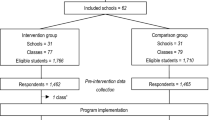Summary
Adolescence, being a period of rapid change and development, is often associated with experiences of turmoil and anxiety. Shyness is common as the adolescent attempts to explore boundaries, gain self-knowledge, and form an identity. An approach successful in treating this type of nervous pre-occupation is Morita therapy. This article describes how Morita therapy, in the form of Morita counselling, was applied in treating 12 shy adolescents seen in 3 groups. Four brief counselling sessions were conducted. The aim of treatment was not to rid the adolescent of shyness but to have them experience accomplishment and be productive despite anxiety symptoms. The main concepts presented were: action can be taken despite experiencing anxiety, emotions cannot willfully be controlled but behaviour can be chosen, and shyness is a reflection of greater sensitivity to life and can serve in a positive way. Positive treatment effects were observed on reported cognitive and behavioural measures and verified by behavioural counts documented. In conclusion, the adolescents appeared to have gained a more positive outlook on their shyness and an awareness of personal control through choice of action. By providing a concrete mechanism for approaching the shyness difficulty, Morita counselling, even in a brief number of sessions, has the potential for making an impact on this age group helping to spare them the anguish of social withdrawal and isolation.
Similar content being viewed by others
References
Alden, L., & Cappe, R. (1986). Chapter 25: Interpersonal process training for shy clients. In: Jones, W.H., Cheek, J.M. & Briggs, S.R. (eds.), Shyness: Perspectives on Research and Treatment New York: Plenum Press.
Arkowitz, H., Hinton, R., Perl, J. & Himadi, W. (1978). Treatment strategies for dating anxiety in college men based on real-life practice. Counseling Psychologist 7: 41–46
Buss, A.H. (1980). Self-Consciousness and Social Anxiety. San Francisco: W.H.Freeman & Co.
Edelstein, B.A., & Eisler, R.M. (1976). Effects of modeling with instructions and feedback on the behavioral components of social skills. Behavior Therapy 7: 382–389.
Eisler, R.M., Hersen, M., & Miller, P.M. (1974). Shaping components of assertive behavior with instructions and feedback. American Journal of Psychiatry 131: 1344–1347.
Erickson, E.H. (1959). Identity and the life cycle, New York, N.Y.: International Universities Press Inc.
Franco, D.P., Christoff, K.A., Crimmins, D.E., & Kelly, J.A. (1983). Social skills training for an extremely shy adolescent: An empirical case study. Behavior Therapy 14: 568–575.
Hansell, S., Mechanic, D., & Brondolo, E. (1986). Introspectiveness and adolescent development. Journal of Youth and Adolescence 15(2).
Ishiyama, F.I. (1983). A case of severe test anxiety treated in Morita therapy: Acceptance and not fighting it. Canadian Counselor 17: 172–174.
Ishiyama, F.I. (1984). Shyness: Anxious social sensitivity and self-isolating tendency. Adolescence 19: 903–911.
Ishiyama, F.I. (1986b). Morita therapy: Its basic features and cognitive intervention for anxiety treatment. Psychotherapy 23: 375–381.
Ishiyama, F.I. (1986c). Brief Morita therapy for social anxiety: A single-case study of therapeutic changes. Canadian Journal of Counselling 20(1): 58–59.
Ishiyama, F.I. (1987a). Use of Morita therapy in shyness counselling in the west: Promoting client's self-acceptance and action taking. Journal of Counselling and Development 65: 547–551.
Ishiyama F.I. (1987b). Measurement of cognitive change and therapeutic effects of Morita therapy: A case study of a single-session treatment of social anxiety in Canada. Seishin Ryoho (Japanese Journal of Psychotherapy).
Kawai, H. & Konso, K. (1960). Discussion on Morita therapy. Psychologia 3: 92–99.
Kegan, R. (1982). The evolving self: Problem and process in the human development. Massachusetts: Harvard University Press.
Leary, M.R. (1983a). Understanding social anxiety: Social, personality and clinical perspectives. Beverly Hills California: Sage Publications.
Miura, M., & Usa, S. (1970). A psychotherapy of neurosis: Morita therapy. Psychologia 13: 18–34.
Morita, S. (1928/1974). Shinkeishitsu-no hontai-oyobi ryoho (True nature and treatment of nervosity). Collected Works 2 Tokyo: Hakuyosha.
Pilkonis, P.A. (1977b). Shyness, public and private, and its relationship to other measures of social behavior. Journal of Personality 45: 585–595.
Reynolds, D.K. (1976). Morita psychotherapy. Berkley: University Press of Hawaii.
Zimbardo, P.G., Pilkonis, P.A. & Norwood, R.M. (1974). The silent prison of shyness. Office of Naval Research Tech. Rep. Z-17, Stanford University.
Zimbardo, P.G. (1977). Shyness. New York: Jove Publications.
Author information
Authors and Affiliations
Rights and permissions
About this article
Cite this article
Donahue, P.A. Helping adolescents with shyness: Applying the Japanese Morita therapy in shyness counselling. Int J Adv Counselling 12, 323–332 (1989). https://doi.org/10.1007/BF00123260
Published:
Issue Date:
DOI: https://doi.org/10.1007/BF00123260




